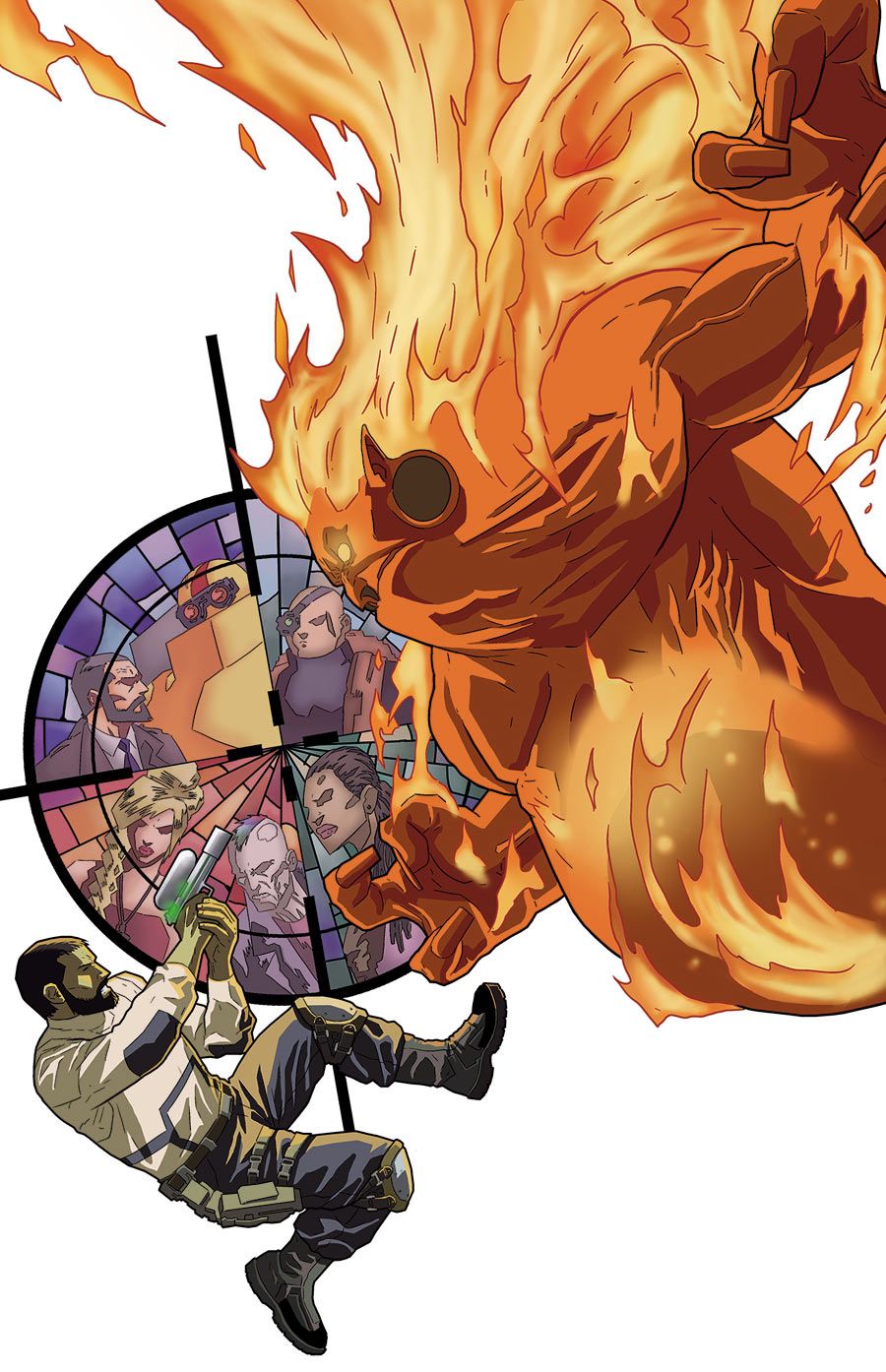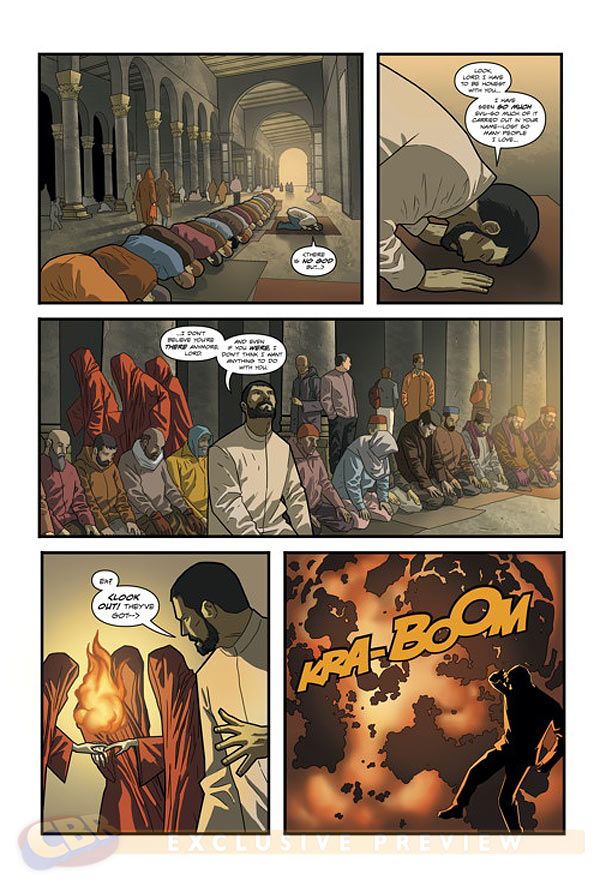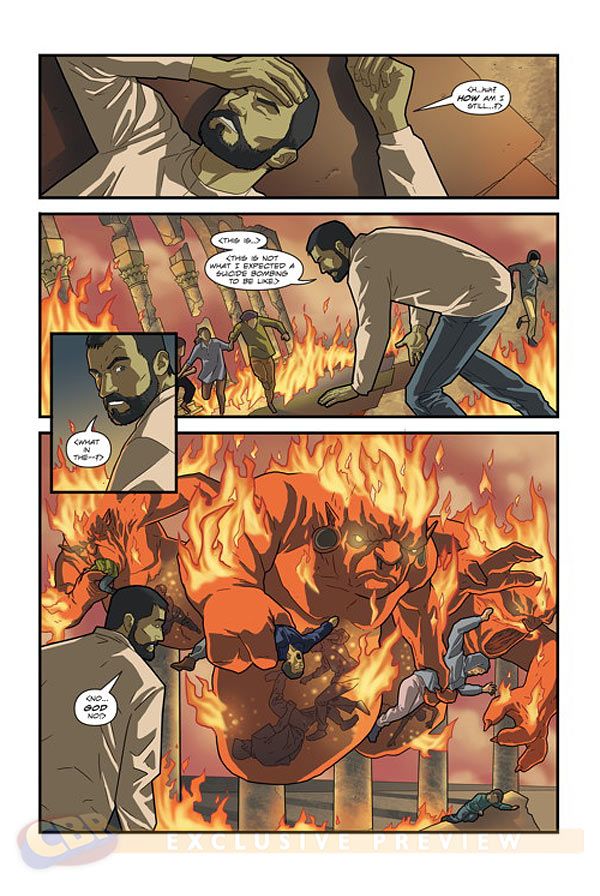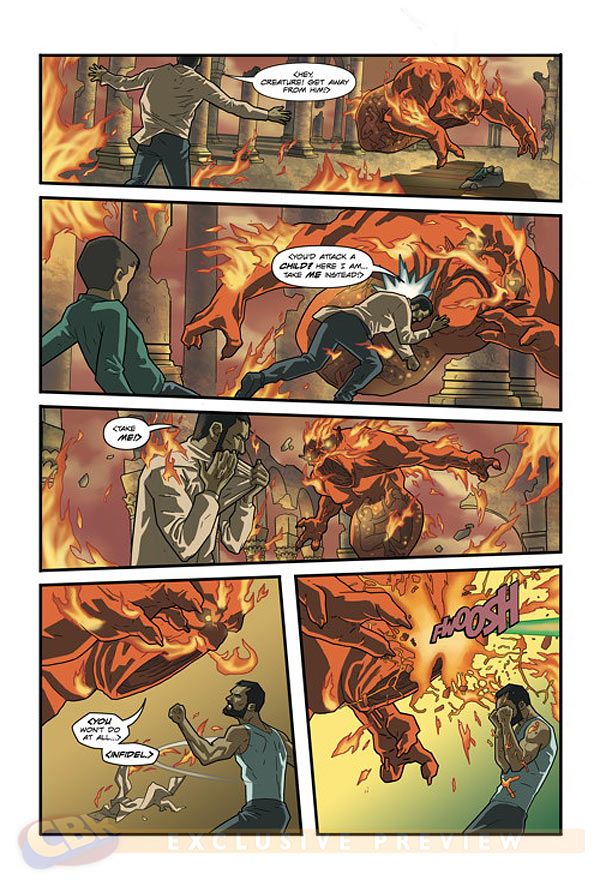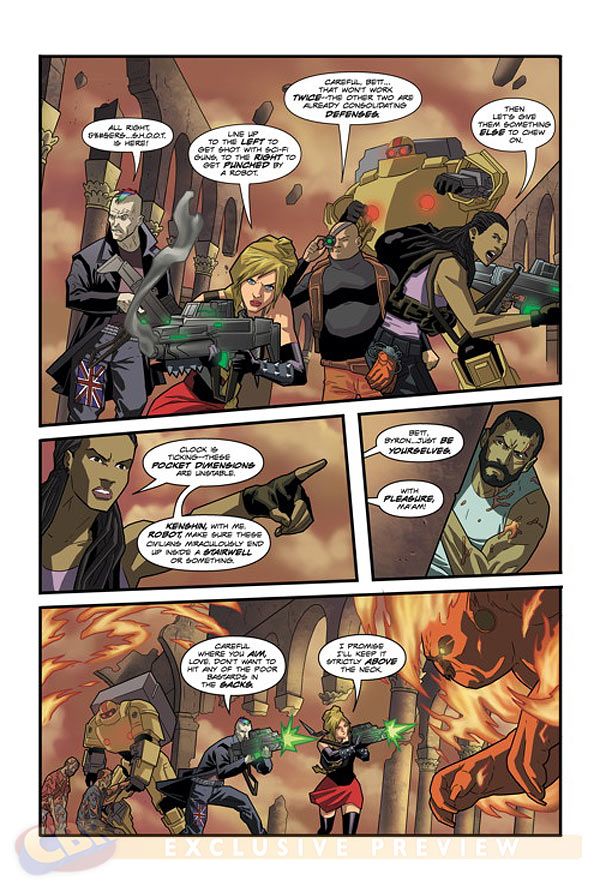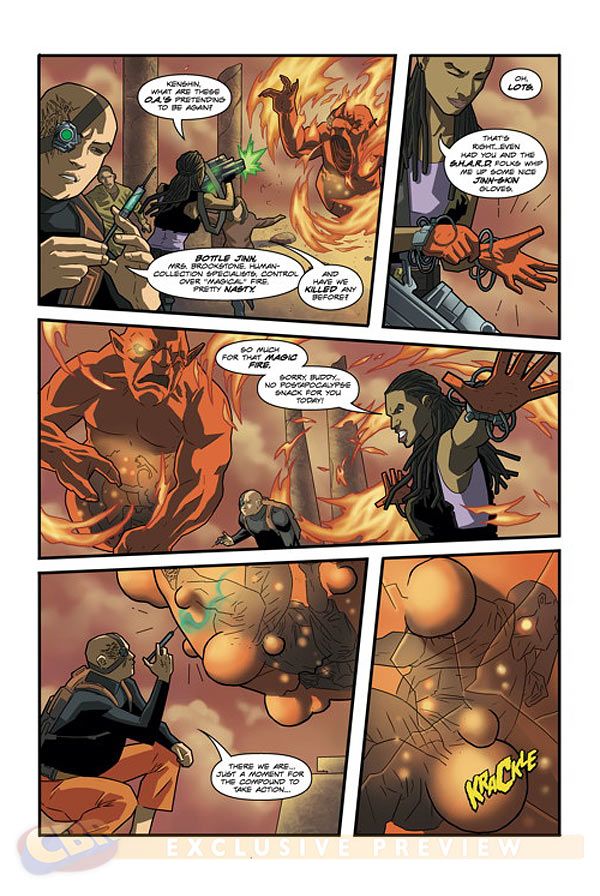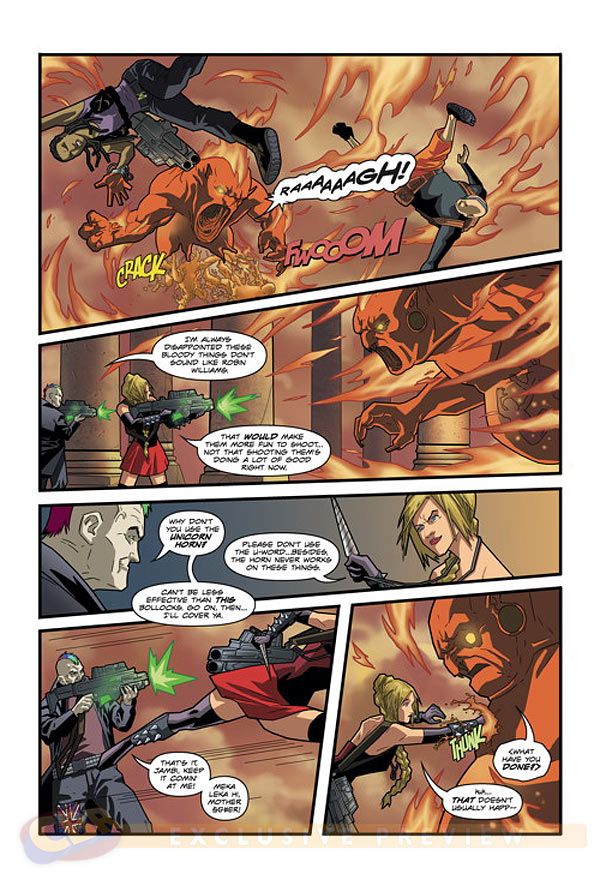Writer Justin Aclin has spent the past few years making his name on licensed titles for Dark Horse Comics, but with his return to creator-owned work, Aclin is getting to write about something he really believes...or doesn't.
This October, Aclin and artist Nicolás Daniel Selma launch the four-issue "S.H.O.O.T. First." Based on Aclin's characters that debuted in Dark Horse's MySpace iteration of their "Dark Horse Presents" title and a subsequent Halloween story on ROBOT 6, the series focuses on a taskforce of monster fighters powered by the fact that they're atheists. The S.H.O.O.T. team -- which means "Secular Humanist Occult Obliteration Taskforce" - battle against other-dimensional beings who take the form of angels, demons, mythological gods and other figures from human religion in order to feed of the beliefs of man.
The writer of books like "Star Wars: Clone Wars - Defenders of the Lost Temple" and the recent "Akaneiro" adaptation tells CBR News that "S.H.O.O.T. First" goes beyond political debate and into real human emotion. Below, Aclin explains the roots of S.H.O.O.T., how atheists and believers alike can see something real in the struggles of the gun-totting team of monster fighters, which member of the squad may be a spy for the Vatican and why Armageddon is much worse than you imagine.
CBR News: Justin, whether readers were able to check out your original "MySpace Dark Horse Presents" short or not, the concept of "S.H.O.O.T. First" is an easy one to grasp: Atheists versus Angels. How does that high concept play out in the series?
Justin Aclin: Basically, you know that these guys fight supernatural creatures, but they don't consider the creatures supernatural. They call them "Outside Actors," and they're basically another race of beings from a parallel world that can self-evolve into something we perceive as supernatural. While posing as beings from mythology or religion, they feed off our belief energy to survive.
But I get the sense that underneath that high concept, there's a strong thread about what it's like to be a person without faith in a world where faith sets the standard for how everything is discussed in society. How was that the big compelling hook for the series?
There are two main characters within the S.H.O.O.T. team. One is called Infidel, who is our kind of point of entry character through whose eyes we're seeing this world, but the real main character is Mrs. Brookstone, the team leader. When I introduced her in the original MySpace short story, it was revealed that her team members don't know a lot about her. So on the very first page of the "S.H.O.O.T. First" miniseries, you start to learn more about her. You meet her son, a six-year-old boy named Ray. She is raising Ray not only as a single mother but also in a secret room in the S.H.O.O.T. headquarters kept apart from the team. Right away, you know that being a mother is very central to her character, but also that she's keeping this a secret from the rest of her teammates.
And as far as that goes, the series has always been about more than the high concept of "atheists hunting supernatural creatures." It's about dealing with real emotions that people who struggle with faith, have lost faith or never had faith have to go through. I hope there are a lot of recognizable emotions and situations that come into this series alongside the crazy action ideas. It's funny because my history with the idea has changed parallel to my history relating to my faith, and eventually my loss of faith. When I started writing this, I was in the early stages of becoming a strident atheist, and the whole thing was just going to be a screed against religious fundamentalism and certainty and all that stuff.
But as I went along developing the ideas, I went beyond that strident stage and into a point where I was living a life feeling, "I know what I am, and I don't need to spend time preaching at people about it. I know other people like me are out there." Then I started to realize that there are issues you deal with when you make this decision or have a change of belief happen to you. One of the biggest ones is "How do you talk to children about death when you don't have the very comforting story about Heaven to fall back on?" That became one of the key emotions that the story revolves around. It's not just dealing with children, but it's about what you lose when you decide to live without faith and know this is the truth for you. You have no other choice but to believe what you believe, but you gain the idea that you can live your own truth. That's the unifying theme of this whole story, and you'll see all the characters go through that in some form or another.
How did you approach the task of opening up this world to new readers?
I'm definitely setting off with the assumption that people will not have read a "MySpace Dark Horse Presents" story from three years ago. [Laughter] That's not the barrier of entry to read this. I had to assume that I'm introducing these characters to people for the very first time. The tough thing was that the short story introduced the whole S.H.O.O.T. team concisely in eight pages, and then I had to find a completely different way to do that in the mini. There are six or seven main characters, the high concept of the universe and then some twists, turns and technical information about how the world and weapons work.
Initially, I was very resistant to the idea of a new guy joining the team and learning the ropes so the team could explain to him how the world worked, but after talking about it with my editor, it just made the most sense. The character of Infidel was always going to be the new guy, so it made sense to use him as the entry point character. But before you get to any of that, there's a big action scene that shows off all the characters.
Well, there are those fun high-concept super spy sci-fi ideas to play with. And the big hook on that front is that the goal for the so-called spiritual beings who are the villains of "S.H.O.O.T. First" is nothing short of Armageddon for planet earth. How does that work in the story and how does it up the stakes from what you've previously done?
In the original short story, the idea that the creatures were feeding off humanity's beliefs was in there, but what we never learned was why this whole S.H.O.O.T. team was built beyond just stopping these creatures from killing humans. Here we'll learn early on that the Outside Actors have many different factions. Some factions evolve into what we would call angels and demons. Some of them are other pantheons from various culture's religions. They all feed off the beliefs of mankind, but what they've started to realize over the past few hundred years is that, as mankind's knowledge of science grows, their food source of belief energy is slowly drying up. Now they've launched into a plan to bring about their own kind of Armageddon. Every single culture has its own apocalyptic prophecy or legend. The Outside Actors figure that if they can bring about an Armageddon that follows the prophecies they've been laying out there, they may lose a portion of humanity, but whatever people are left will believe in them forever. Scientific progress will lose, and the struggle will be over. It's a way of weeding out the bad crops.
It sounds odd to say it like this, but there's a long history in comics of superspy taskforce teams with acronym names, from S.H.I.E.L.D. to A.R.G.U.S. Was there a particular inspiration for how this series plays out on that genre front?
I think the key for me with this series came as soon as I realized that "Secular Humanist" could start a bunch of "Sh-" words. When I came up with "Secular Humanist Occult Obliteration Taskforce," I just cackled to myself and said, "Okay. This is ridiculous and fun. I want to write something about this." So the acronym is central to the whole project to me, but there are also a lot of the superspy trappings that play in. They've got a secret base and a jet plane and stuff like that. But certainly, the main genre I'm playing in comes more from the Dark Horse supernatural action series like "B.P.R.D." and that ilk. I wanted to take something in that vein and put a twist on it.
At the beginning, the twist was the idea that when you usually see these monster hunter stories, they team is always doing their jobs on the monster's terms. For a vampire, you always see the hunter bring a stake and garlic. You never hear them say, "Aw, vampires are bullshit" and then just go after them with their own weaponry. [Laughter] In the case of S.H.O.O.T., they've got these guns that fire bullets that are powered by their own disbelief. The bullets are actually a vessel for the S.H.O.O.T. member's own ideas. They are their own weapon, and the gun just helps deliver that.
Since the original story came out, you've done a number of licensed titles including some "Star Wars: Clone Wars" graphic novels and recently the "Akaneiro" video game tie-in. What have you learned the most from those kinds of projects that you're bringing back into a creator-owned book?
When you're working on something like "Star Wars" books especially, you understand that there are going to be people keeping track of all the characters you introduce, and everything you do will eventually be put into Wookieepedia and cross-referenced. So you can't say that Obi Wan has six fingers on his right hand because there's 35 years worth of fiction out there that disagrees with you. You have to be very consistent with the world given to you.
With S.H.O.O.T., I'm creating a whole world here myself, and I'm creating a whole cosmology for the world. And I have to keep that same idea in mind. Even though I'm creating this, I can't lay down a rule about how the Outside Actors work and then contradict it two issues later. It has to be treating it like someone is going to make a Wiki about your story! [Laughs] You can make anything up, but whatever you make up has to be consistent. I'm trying to look at this in the same way as a person who's trying to pick the story apart would look at it. There are certain times in the story where I say, "Based on the rules we've laid down, why wouldn't this have happened earlier?" and so long as I can come up with a reason that's consistent with the established rules, that's fine. But if it's just, "That's what needs to happen for the story to happen" then that's not good enough. So I drew from the "Star Wars" experience especially because even if this is a universe that hasn't had millions and millions of words of fiction contributed to it already, you've got to stay consistent with what you've already put out there.
And I will say that even though the MySpace story was a prototype in some ways -- it was not done with my co-creator on this mini Nicolás Daniel Selma -- I still kept that story in mind while writing this. It all fits together, as does the Robot 6 short story I wrote. And when all is said and done, I'll probably do a blog post that goes back and explains all the little Easter Eggs that were in the earlier stories. One of the things we find out in both the short story and the first issue of the series is that there's a member of the team that's working as a traitor. They're conspiring with the Vatican to betray the team, and there are clues to who this person is in the first issue and in the short story as well. I'm playing fair with the audience.
To wrap, I'd like you to address someone with doubts in their hearts about whether "S.H.O.O.T. First" is a comic book for them. What would you say to them to win them to your cause?
So they're having a crisis of faith on whether or not to trust me? [Laughter] I'd say that with "S.H.O.O.T. First," I really created the kind of comic that I wanted to read. I would like to think that applies to a lot of other people as well. It's got insanely great artwork by Nicolás Daniel Selma and wonderful colors by Marlac who did an amazing job bringing this world to life. They get to go crazy on the bizarre creatures the team is fighting. In the first issue, they're fighting "Bottle Jinn" who are essentially genies who kidnap people and put them inside themselves. It's very creepy. Then in the second issue, they're fighting a giant monster that has a unique twist on an old idea. In the third issue, they fight a group of fairies, elves and dragons that call themselves the Folklorics. Then in the fourth issue, it's a battle royale. In every single issue, you'll see spectacular battles against really cool mythological creatures.
I also think that I set out to tell a story that people will find relatable and will see in it some emotions they've experienced themselves. And I know there are a lot of atheists out there on the internet, but even people of faith can find something in this. It's not a book that's disrespectful of religion even though it never goes "Maybe religion is right." In the world of the book, S.H.O.O.T. is right, but we don't go out and directly criticize a bunch of religious beliefs. It's not meant to shut anyone out, and I think there are emotions and character moments that just about anybody can relate to.
Finally, it's a really complete and epic story told in four issues. Even though Nico and I want to do more "S.H.O.O.T. First" in the future, we didn't want to leave anything on the table. I tell the whole story I wanted to tell in four issues, so you get apocalypses either averted or not, traitors revealed with the results of their treachery coming home to roost and crazy twists and turns with shocking truths about the characters. If I'd been writing this as an ongoing series, what happens in this book would have taken 12 issues or more. But we managed to just skip to all the good parts and fit it into four. So I think if you're willing to drop $4 a pop for four issues, you'll get a complete, exciting comic book story.


